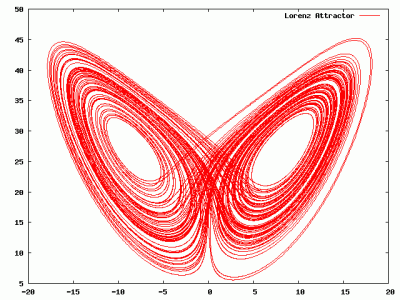The Strange Attraction of Strange Attractors…
I’ll just lead off with a picture:
This is a graph of the so-called “Lorenz attractor”, first described by mathematician Edward Lorenz in his paper Deterministic Nonperiodic Flow back in 1962. I learned about this kind of stuff probably back in highschool by reading Scientific American. Anyway, the equations themselves are pretty simple, but describe paths which are nonperiodic, and which are unstable: for two points very near each other, their evolution rapidly diverges, and they no longer follow identical paths.
Making these graphs was really just a diversion: I’ve got it in my head that creating an analog circuit that simulates these equations might be a fun thing to do. This is boldly going where others have gone before, so here are some links:
Build a Lorenz Attractor has a nifty little circuit that has two analog multipliers and three op amps. Checking with digikey, the MPY634 multipliers seem pretty spendy for something that is just a lark ($28 a piece, ouch), but Analog Devices makes some devices which seem like they will perform adequately, and cost $8 a piece.
A Simple Circuit Implementation of a Chaotic Lorenz System by Ned Corron uses these less expensive parts (AN633 multipliers, and the super cheapie TL082 op amps) and probably would be a good place to start.
And, of course, we need a YouTube video. Jeri and Chris show off a hardware implementation of the first circuit that Chris assembled:
I didn’t realize until later that the first article was written by Paul Horowitz, one of the authors of the incredible book The Art of Electronics by Horowitz and Hill. Digging a bit more, I found an actual lecture by Paul Horowitz on the subject, posted by user harvardphysics on YouTube:
Addendum: Here are some more links.
From the analogmuseum.org website, a nifty page that points out that if you change the value of the integrating caps, you can effectively change the speed of calculation, allowing the analog computer to directly drive a pen plotter.
I got pointed to the Analog Museum from this page, which in addition to demonstrating the Lorenz attractor running on an analog computer also has schematics and parts lists for actually building an analog computer, again using the AN633 analog multipliers from Analog Devices. Neat.

I recall burning three or four weeks of a sabbatical getting Saccade.com on the air with Wordpress. So much tweaking…